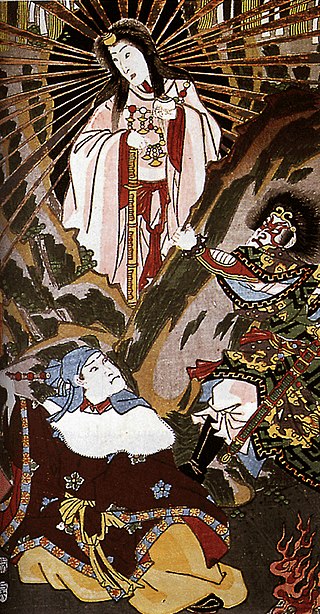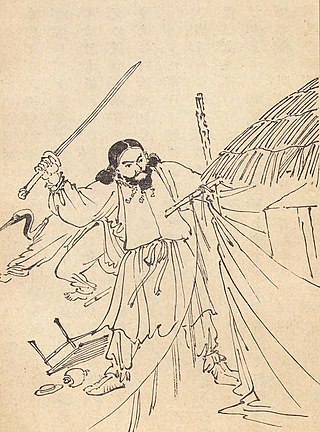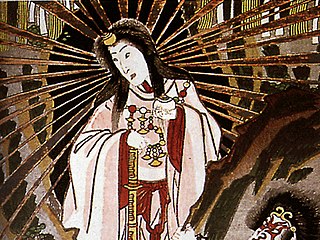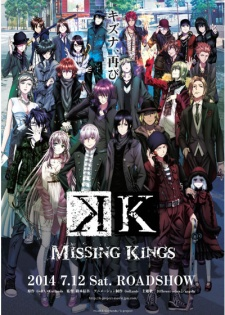This article needs additional citations for verification .(January 2016) |
The following is a list of characters for the K anime and manga series.
This article needs additional citations for verification .(January 2016) |
The following is a list of characters for the K anime and manga series.
They are a thug-like band (though they are not actually thugs), driven mostly by action and excitement, crying their slogan 'No Blood, no bone, no ash' when they gather. The king is capable of using fire for their attacks.
This is a group which stays at their headquarters, forming a police like organization. The members wield swords, which are drawn only to enforce the law.
A high school teacher who professions in English. She formerly taught Mikoto Suoh and Izumo Kusanagi. She is also Anna's paternal aunt. She appears in K Side:Red and K: Memory of Red.
A female Strain who works as a well-known assassin. She appears in K: Memory of Red.
Rikio Kamamoto's childhood friend. She appears in K: Memory of Red and K: Missing Kings.
The previous Red King and the late predecessor to Mikoto Suoh. He is the cause of the Kagutsu Crater incident.
A member of Scepter 4. He’s appears in the K Side:Blue. He was killed when he stepped in front of a bullet that was meant for Reisi Munakata.
The previous Blue King and the late predecessor to Reisi Munakata. He was killed by Gōki Zenjō.
A general Affairs Section clerk who works at Scepter 4. She is a good friend of Seri Awashima. She appears in K: Days of Blue.
A member of Scepter 4. Twin brother of Hayato Minato.
A member of Scepter 4. Twin brother of Akito Minato.
A girl who went to the same school as Saruhiko Fushimi and Misaki Yata. Saruhiko's cousin. She admired Saruhiko and wanted to be like him, and she seems to have been jealous of Yata. Later she joined Jungle. She appears in the Lost Small World novel and manga.
Father of Saruhiko Fushimi. Highly intelligent, but he never did anything useful with his life. He was mentally and psychologically abusive over his son. Later he got ill and died. He appears in the Lost Small World novel and manga, and also in Gakuen K.

Amaterasu Ōmikami, often called Amaterasu for short, also known as Ōhirume no Muchi no Kami (大日孁貴神), is the goddess of the sun in Japanese mythology. Often considered the chief deity (kami) of the Shinto pantheon, she is also portrayed in Japan's earliest literary texts, the Kojiki and the Nihon Shoki, as the ruler of the heavenly realm Takamagahara and the mythical ancestress of the Imperial House of Japan via her grandson Ninigi. Along with her siblings, the moon deity Tsukuyomi and the impetuous storm god Susanoo, she is considered to be one of the "Three Precious Children", the three most important offspring of the creator god Izanagi.
Susanoo, often referred to by the honorific title Susanoo-no-Mikoto, is a kami in Japanese mythology. The younger brother of Amaterasu, goddess of the sun and mythical ancestress of the Japanese imperial line, he is a multifaceted deity with contradictory characteristics, being portrayed in various stories either as a wild, impetuous god associated with the sea and storms, as a heroic figure who killed a monstrous serpent, or as a local deity linked with the harvest and agriculture. Syncretic beliefs of the Gion cult that arose after the introduction of Buddhism to Japan also saw Susanoo becoming conflated with deities of pestilence and disease.
The Kojiki, also sometimes read as Furukotofumi or Furukotobumi, is an early Japanese chronicle of myths, legends, hymns, genealogies, oral traditions, and semi-historical accounts down to 641 concerning the origin of the Japanese archipelago, the kami (神), and the Japanese imperial line. It is claimed in its preface to have been composed by Ō no Yasumaro at the request of Empress Genmei in the early 8th century (711–712), and thus is usually considered to be the oldest extant literary work in Japan.

Ajisukitakahikone is a kami in Japanese mythology. He is one of the sons of Ōkuninushi and the tutelary deity of Kamo.

Izumo-taisha, officially Izumo Ōyashiro, is one of the most ancient and important Shinto shrines in Japan. No record gives the date of establishment. Located in Izumo, Shimane Prefecture, it is home to two major festivals. It is dedicated to the god Ōkuninushi, famous as the Shinto deity of marriage and to Kotoamatsukami, distinguishing heavenly kami. The shrine is believed by many to be the oldest Shinto shrine in Japan, even predating the Ise Grand Shrine.

A Shinto shrine is a structure whose main purpose is to house ("enshrine") one or more kami, the deities of the Shinto religion.

Totsuka-no-Tsurugi is not a specific sword, but a common noun for any sword of this length. In Japanese mythology, numerous deities own a sword of this kind. Some examples of well-known Totsuka-no-Tsurugi:

Kamisama Dolls is a Japanese manga series written and illustrated by Hajime Yamamura. It was serialized in Shogakukan's seinen manga magazine Monthly Sunday Gene-X from December 2006 to February 2013, with its chapters collected in twelve tankōbon volumes. An anime adaptation aired from July to September 2011.
Tanken Driland is a Japanese mobile game developed by GREE, Inc. A manga adaptation began serialization in Jump Square in 2012. An anime series by Toei Animation and TV Tokyo began airing on 7 July 2012.

K is a Japanese anime series created by the animation studio GoHands and GoRA, a group consisting of seven anonymous authors known as Kōhei Azano, Tatsuki Miyazawa, Yukako Kabei, Yashichiro Takahashi, Hideyuki Furuhashi, Suzu Suzuki, and Rei Rairaku. The series is directed by Shingo Suzuki, who also serves as its character designer. It began airing on MBS on October 5, 2012. The anime has been licensed by Viz Media in North America and by Madman Entertainment in Australia. The series is set when Japan is secretly being ruled by seven Kings of psychic clans called the Seven Clans of Color. Yashiro Isana, a seemingly normal student of Ashinaka High School, is targeted by HOMRA of the Red Clan and Scepter 4 of the Blue Clan, following the murder of pacifist Tatara Totsuka from HOMRA. With the help of a highly skilled swordsman named Kuroh Yatogami and a feline Strain with the ability of sensory interference named Neko, Yashiro rediscovers his true identity.
Battle Spirits: Sword Eyes is a Japanese anime series. It premiered on 9 September 2012.

The Ending Chronicle is a light novel series written by Minoru Kawakami and illustrated by Satoyasu (さとやす). It had 14 volumes published from 2003 to 2005 by Dengeki Bunko. It takes place in the past of Horizon in the Middle of Nowhere, another of Kawakami's light novel series. The series takes place in the second era of a six-stage universe, with Kawakami's other works encompassing the other five.

K: Missing Kings is a 2014 Japanese animated film based on the K anime series. The movie takes place one year after the anime in the summer. The movie was released on July 12, 2014.

Toilet-Bound Hanako-kun is a Japanese manga series written by Iro and illustrated by Aida, which results in their conjoined name 'AidaIro'. It has been serialized in Square Enix's magazine Monthly GFantasy since 2014. It has been collected in twenty-one tankōbon volumes as of February 2024. The story follows Nene Yashiro, a first-year high school student fond of occult stories, who ardently desires a boyfriend. For this, she tries to invoke Hanako-san from the toilet.

Salaryman's Club is a Japanese anime television series animated by Liden Films, directed by Aimi Yamauchi and written by Yamauchi and Teruko Utsumi. Original character designs are provided by Suzuhito Yasuda, while Majiro adapts the designs for animation. The music is composed by fox capture plan. The series aired on TV Asahi's NUMAnimation block from January 30 to April 17, 2022. The opening theme song is "The Warrior" by Novelbright, while the ending theme song is "Nisen Gohyaku Man no Ichi" by Mafumafu. Crunchyroll has licensed the series outside of Asia. Medialink licensed the series in Southeast Asia. A spin-off manga illustrated by Kou Sakashita was serialized on Bushiroad's Comic Bushiroad Web magazine from October 2022 to August 2023.